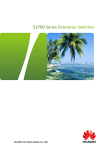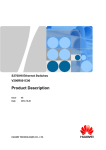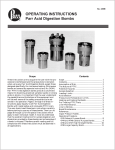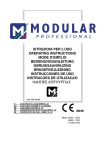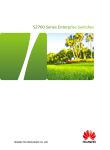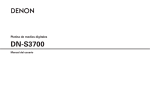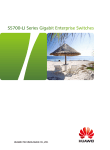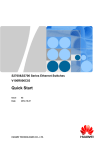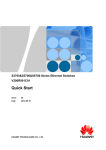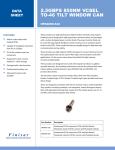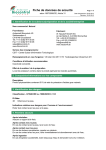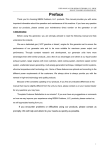Download Huawei S37/27 500W AC
Transcript
Quidway S3700 Series Ethernet Switches V100R006C00 Hardware Description Issue 03 Date 2012-07-20 HUAWEI TECHNOLOGIES CO., LTD. Copyright © Huawei Technologies Co., Ltd. 2012. All rights reserved. No part of this document may be reproduced or transmitted in any form or by any means without prior written consent of Huawei Technologies Co., Ltd. Trademarks and Permissions and other Huawei trademarks are trademarks of Huawei Technologies Co., Ltd. All other trademarks and trade names mentioned in this document are the property of their respective holders. Notice The purchased products, services and features are stipulated by the contract made between Huawei and the customer. All or part of the products, services and features described in this document may not be within the purchase scope or the usage scope. Unless otherwise specified in the contract, all statements, information, and recommendations in this document are provided "AS IS" without warranties, guarantees or representations of any kind, either express or implied. The information in this document is subject to change without notice. Every effort has been made in the preparation of this document to ensure accuracy of the contents, but all statements, information, and recommendations in this document do not constitute a warranty of any kind, express or implied. Huawei Technologies Co., Ltd. Address: Huawei Industrial Base Bantian, Longgang Shenzhen 518129 People's Republic of China Website: http://www.huawei.com Email: [email protected] Issue 03 (2012-07-20) Huawei Proprietary and Confidential Copyright © Huawei Technologies Co., Ltd. i Quidway S3700 Series Ethernet Switches Hardware Description About This Document About This Document Intended Audience This document provides an overall description of the S3700, details about each chassis and module, cables available to the device, and lists of components. This document describes hardware features of the S3700, which helps intended readers obtain detailed information about each chassis, module and cable, and rapidly locate specific information through lists of components. This document is intended for: l Network planning engineers l Hardware installation engineers l Commissioning engineers l On-site maintenance engineers l System maintenance engineers Symbol Conventions The symbols that may be found in this document are defined as follows. Symbol Description DANGER WARNING CAUTION Issue 03 (2012-07-20) Indicates a hazard with a high level of risk, which if not avoided, will result in death or serious injury. Indicates a hazard with a medium or low level of risk, which if not avoided, could result in minor or moderate injury. Indicates a potentially hazardous situation, which if not avoided, could result in equipment damage, data loss, performance degradation, or unexpected results. TIP Indicates a tip that may help you solve a problem or save time. NOTE Provides additional information to emphasize or supplement important points of the main text. Huawei Proprietary and Confidential Copyright © Huawei Technologies Co., Ltd. ii Quidway S3700 Series Ethernet Switches Hardware Description About This Document Change History Updates between document issues are cumulative. Therefore, the latest document issue contains all updates made in previous issues. Changes in Issue 03 (2012-07-20) Based on issue 02 (2012-04-30), the document is updated as follows: The following information is modified: l 1 Overview of the S3700 l 4 Cables Changes in Issue 02 (2012-04-30) Based on issue 01 (2011-07-15), the document is updated as follows: The following information is modified: l 1.3 Device Structure l 6 List of Optical Modules Changes in Issue 01 (2011-07-15) Initial commercial release. Issue 03 (2012-07-20) Huawei Proprietary and Confidential Copyright © Huawei Technologies Co., Ltd. iii Quidway S3700 Series Ethernet Switches Hardware Description Contents Contents About This Document.....................................................................................................................ii 1 Overview of the S3700..................................................................................................................1 1.1 Introduction........................................................................................................................................................2 1.1.1 Positioning.................................................................................................................................................2 1.1.2 Product Characteristics..............................................................................................................................2 1.2 S3700 Device Models and Naming Rules..........................................................................................................3 1.3 Device Structure.................................................................................................................................................6 1.4 ESD Jack.............................................................................................................................................................9 1.5 System Configuration.........................................................................................................................................9 1.6 Physical Specifications.....................................................................................................................................10 2 Power Supply Unit......................................................................................................................12 2.1 Power Supply Configuration............................................................................................................................13 2.2 Power Supply Unit Working Mode..................................................................................................................14 2.2.1 Working Mode of DC Power Supply Units.............................................................................................14 2.2.2 Working Mode of Non-PoE AC Power Supply Units.............................................................................14 2.2.3 Working Mode of PoE AC Power Supply Units.....................................................................................15 2.3 AC PoE Power Supply Units............................................................................................................................15 2.3.1 Function Overview..................................................................................................................................16 2.3.2 Panel........................................................................................................................................................16 2.3.3 Technical Specifications..........................................................................................................................17 3 Heat Dissipation System............................................................................................................19 3.1 Heat Dissipation Mode.....................................................................................................................................20 3.2 Fan Module.......................................................................................................................................................22 4 Cables.............................................................................................................................................24 4.1 DC Power Cables..............................................................................................................................................25 4.2 AC Power Cables..............................................................................................................................................26 4.3 Ground Cables..................................................................................................................................................27 4.4 Console Cables.................................................................................................................................................28 4.5 Network Cables................................................................................................................................................29 4.6 Optical Fibers...................................................................................................................................................31 4.7 Stack cables......................................................................................................................................................35 Issue 03 (2012-07-20) Huawei Proprietary and Confidential Copyright © Huawei Technologies Co., Ltd. iv Quidway S3700 Series Ethernet Switches Hardware Description Contents 5 List of Indicators..........................................................................................................................37 5.1 Indicators on the Front Panel............................................................................................................................38 5.2 Fan Indicators...................................................................................................................................................42 5.3 Power Indicators...............................................................................................................................................43 6 List of Optical Modules..............................................................................................................46 6.1 SFP Optical Module (FE) Attributes................................................................................................................47 6.2 ESFP Optical Module (FE) Attributes..............................................................................................................47 6.3 ESFP Optical Module (GE) Attributes.............................................................................................................48 6.4 ESFP CWDM-SFP Optical Module.................................................................................................................49 Issue 03 (2012-07-20) Huawei Proprietary and Confidential Copyright © Huawei Technologies Co., Ltd. v Quidway S3700 Series Ethernet Switches Hardware Description 1 Overview of the S3700 1 Overview of the S3700 About This Chapter 1.1 Introduction This section describes the characteristics of the S3700. 1.2 S3700 Device Models and Naming Rules This section describes device models and naming rules of the S3700. 1.3 Device Structure This section describes the structure of the S3700. 1.4 ESD Jack This section describes the functions of the ESD jack on the S3700. 1.5 System Configuration 1.6 Physical Specifications Issue 03 (2012-07-20) Huawei Proprietary and Confidential Copyright © Huawei Technologies Co., Ltd. 1 Quidway S3700 Series Ethernet Switches Hardware Description 1 Overview of the S3700 1.1 Introduction This section describes the characteristics of the S3700. 1.1.1 Positioning WARNING The Quidway S3700 Ethernet switches are class A products. Customers should take preventative measures as the operating devices may cause radio interference. The Quidway S3700 switch (S3700 for short) is an enterprise networks access device that provides access and data transport functions. The S3700 is developed by Huawei to meet the requirements for reliable access, aggregation, and high-quality transmission of multiple services on an enterprise networks . The S3700 functions as the access device of the enterprise networks. The S3700 provides large capacity, high port density, and cost-effective packet forwarding capabilities. The S3700 also provides multi-service access capabilities, excellent extensibility, quality of service (QoS) guarantee, powerful multicast replication, and carrier-class security, and can be used to build high-reliability ring topologies. 1.1.2 Product Characteristics Energy-Saving Design The S3700 saves energy in the following ways: l Some models adopt natural heat dissipation, so fans are not required. NOTE Currently, the S3700-28TP-EI-MC-AC, S3700-28TP-SI-AC, S3700-28TP-SI-DC, S3700-28TP-EIAC, and S3700-28TP-EI-DC adopt natural heat dissipation. l The interface chip switches to the power saving mode when an interface is idle, which means that no peer device is connected to the interface. l It uses advanced highly-integrated and energy-saving chips. With the help of the intelligent device management system, the chips improve system performance and also reduce system power consumption. Natural heat dissipation has the following advantages: l Product reliability is high. l There is no noise pollution. l Fans do not need to be maintained periodically, which saves the maintenance cost. l The system does not have additional power consumption generated by fans, which improves the power efficiency. l Boards are prevented from being eroded. Issue 03 (2012-07-20) Huawei Proprietary and Confidential Copyright © Huawei Technologies Co., Ltd. 2 Quidway S3700 Series Ethernet Switches Hardware Description 1 Overview of the S3700 Advanced Surge Protection Technique The S3700 uses the Huawei patented built-in surge protection technique. This technique protects devices against lightning in terrible weather and increases device security. Convenient PoE Power Supply The S3700 PoE model has the Power over Ethernet (PoE) function. It provides centralized power supply for IP phones, wireless access points (APs), portable device chargers, POS machines, cameras, and data collectors by using twisted pairs. Complying with IEEE 802.3af and IEEE 802.3at, the S3700 PoE model is able to remotely provide power for the devices of different vendors. IEEE 802.3at delivers a maximum of 30 W power. This allows IEEE 802.3at to support IP video phones, dualband WiFi APs, IP cameras, multi-function STBs, and RFIDs, and simplifies the network. The S3700 PoE model has the ability to control power supply based on time range, which effectively manages network devices, reduces power consumption, and lowers the OPEX. 1.2 S3700 Device Models and Naming Rules This section describes device models and naming rules of the S3700. Device Models To meet diverse customer requirements, the S3700 provides a variety of models. Table 1-1 lists these device models. You can select a device model as required. Table 1-1 Device models Produ ct Series Model Maximum Number of Interfaces S3700 S3700-28TP-SI-AC 28 S3700-28TP-SI-DC There are twenty-four 10/100BASE-T Ethernet interfaces, two GE SFP interfaces, and two GE combo interfaces (10/100/1000BASE-T +100/1000BASE-X). S3700-28TP-EI-AC S3700-28TP-EI-DC S3700-28TP-EI-MC-AC S3700-28TP-EI-24S-AC 28 There are twenty-four 100BASE-X Ethernet interfaces, two GE SFP interfaces, and two GE combo interfaces (10/100/1000BASE-T +100/1000BASE-X). S3700-52P-SI-AC 52 S3700-52P-EI-AC There are forty-eight 10/100BASE-T Ethernet interfaces, two 100/1000BASE-X Ethernet optical interfaces, and two GE SFP interfaces. S3700-52P-EI-DC Issue 03 (2012-07-20) Huawei Proprietary and Confidential Copyright © Huawei Technologies Co., Ltd. 3 Quidway S3700 Series Ethernet Switches Hardware Description Produ ct Series 1 Overview of the S3700 Model Maximum Number of Interfaces S3700-52P-EI-24S-AC 52 S3700-52P-EI-24S-DC There are twenty-four 10/100BASE-T Ethernet interfaces, twenty-four 100BASE-X Ethernet interfaces, two 100/1000BASE-X Ethernet optical interfaces, and two GE SFP interfaces. S3700-52P-EI-48S-AC 52 S3700-52P-EI-48S-DC There are forty-eight 100BASE-X Ethernet interfaces, two 100/1000BASE-X Ethernet optical interfaces, and two GE SFP interfaces. S3700-28TP-PWR-EI 28 There are twenty-four 10/100BASE-T Ethernet interfaces, two GE SFP interfaces, and two GE combo interfaces (10/100/1000BASE-T +100/1000BASE-X). S3700-52P-PWR-EI 52 There are forty-eight 100BASE-X Ethernet interfaces, two 100/1000BASE-X Ethernet optical interfaces, and two GE SFP interfaces. Naming Rules The following are the naming rules of the S3700-28TP-PWR-EI, S3700-52P-EI-24S-DC, S3700-28TP-SI-AC and S3700-28TP-EI-MC-AC. Issue 03 (2012-07-20) Huawei Proprietary and Confidential Copyright © Huawei Technologies Co., Ltd. 4 Quidway S3700 Series Ethernet Switches Hardware Description 1 Overview of the S3700 Figure 1-1 Naming rules S3700-28TP-PWR-EI A B CD E F S3700-52P-EI-24S-DC CD F G H S3700-28TP-SI-AC CD F H S3700-28TP-EI-MC-AC C D F I H Ide ntifi er Description A Switch. B Product series. "37" indicates the S3700 series. C Maximum number of interfaces. NOTE The number of interfaces on an S3700 can be 28, or 52, depending on the device model. D Uplink interface type: l P: A device has optical interfaces. l TP: A device has combo interfaces supporting optical and electrical interfaces. E The S3700 supports Power over Ethernet (PoE). NOTE If this letter is not displayed, PoE is not supported. Issue 03 (2012-07-20) Huawei Proprietary and Confidential Copyright © Huawei Technologies Co., Ltd. 5 Quidway S3700 Series Ethernet Switches Hardware Description 1 Overview of the S3700 Ide ntifi er Description F Software version type: l EI: enhanced version, supporting enhanced features l SI: standard version, supporting basic features G Downlink interface type. The value 24S indicates that 24 downlink interfaces of the S3700-52P-EI-24S are optical interfaces. NOTE If this letter is not displayed, all downlink interfaces are electrical interfaces. H Powering mode: l AC: alternating current power l DC: direct current power I The device has monitoring interfaces. 1.3 Device Structure This section describes the structure of the S3700. The S3700 adopts an integrated hardware platform that provides the front-access structure. An S3700 consists of the chassis, power supply unit, fan, and switch control unit (SCU). The width of an S3700 complies with industry standards, and the S3700 can be installed in an IEC297 cabinet or an ETSI cabinet. NOTE The S3700 is 1 U (1 U = 44.45 mm) high. l The dimensions of S3700-28TP-EI-MC-AC, S3700-28TP-SI-AC, S3700-28TP-EI-AC, S3700-28TPSI-DC, S3700-28TP-EI-DC, S3700-28TP-EI-24S-AC, S3700-52P-SI-AC, S3700-52P-EI-DC or S3700-52P-EI-AC are 442.0 mm x 220.0 mm x 43.6 mm (width x depth x height). l The dimensions of S3700-52P-EI-24S-AC, S3700-52P-EI-24S-DC, S3700-52P-EI-48S-AC, S3700-52P-EI-48S-DC, S3700-28TP-PWR-EI or S3700-52P-PWR-EI are 442.0 mm×420.0 mm× 43.6 mm (width x depth x height). S3700 Appearances Table 1-2 shows the front views of S3700. Table 1-2 S3700 front views Model S3700-28TPSI-AC Image 1 2 4 5 9 10 12 S3700-28TPEI-AC Issue 03 (2012-07-20) Huawei Proprietary and Confidential Copyright © Huawei Technologies Co., Ltd. 6 Quidway S3700 Series Ethernet Switches Hardware Description Model 1 Overview of the S3700 Image S3700-28TPSI-DC 1 3 4 5 1 2 4 6 9 10 12 S3700-28TPEI-DC S3700-28TPEI-24S-AC S3700-52PEI-24S-AC 9 5 10 12 6 9 11 12 S3700-52PEI-24S-DC S3700-52PEI-48S-AC 7 9 11 12 8 9 11 12 S3700-52PEI-48S-DC S3700-52PEI-AC S3700-52PEI-DC S3700-52PSI-AC S3700-28TPPWR-EI 5 9 S3700-52PPWR-EI 12 8 S3700-28TPEI-MC-AC 1 1. Ground screw Issue 03 (2012-07-20) 10 2 4 2. AC jack 5 9 1112 9 10 3. DC jack Huawei Proprietary and Confidential Copyright © Huawei Technologies Co., Ltd. 12 13 4. Switch 7 Quidway S3700 Series Ethernet Switches Hardware Description 1 Overview of the S3700 5. Twenty-four 10/100BASE-T Ethernet interfaces 6. Twenty-four 7. Forty-eight 8. Forty-eight 100BASE-X Ethernet 100BASE-X Ethernet 10/100BASE-T interfaces interfaces Ethernet interfaces 9. Two 1000M uplink 10. Two 1000M interfaces (SFP) combo interfaces (10/100/1000BASET+100/1000BASEX) 11. Two 100/1000BASE-X Ethernet optical interfaces 12. One console interface 13. Two monitoring ports NOTE By default, a combo interface works in the auto mode. In the auto mode, if the electrical interface is connected to a network cable first, the combo interface works as an electrical interface to transmit data; if the optical interface is connected to a fiber first, the combo interface works as an optical interface to transmit data. If the electrical interface and optical interface are connected simultaneously, the combo interface works as an optical interface. Table 1-3 shows the rear views of S3700. Table 1-3 S3700 rear views Model Image S3700-28TPSI-AC S3700-28TPEI-AC S3700-28TPSI-DC S3700-28TPEI-DC S3700-28TPEI-MC-AC S3700-28TPEI-24S-AC S3700-52PEI-24S-AC 4 3 1 S3700-52PEI-48S-AC S3700-52PEI-24S-DC 4 3 2 S3700-52PEI-48S-DC Issue 03 (2012-07-20) Huawei Proprietary and Confidential Copyright © Huawei Technologies Co., Ltd. 8 Quidway S3700 Series Ethernet Switches Hardware Description Model 1 Overview of the S3700 Image S3700-52PEI-AC 4 3 1 4 3 2 S3700-52PSI-AC S3700-52PEI-DC S3700-28TPPWR-EI 45 6 7 S3700-52PPWR-EI 1. AC jack 2. DC jack 3. Switch 5. ESD jack 6. Fan module 7. Power supply unit slot 4. Ground screw 1.4 ESD Jack This section describes the functions of the ESD jack on the S3700. The S3700 has an electromagnetic discharge (ESD) jack on the chassis. When installing the S3700, wear an ESD wrist strap. Connect the ESD wrist strap to the ESD jack on the chassis, as shown in Figure 1-2. Figure 1-2 ESD jack 1.5 System Configuration Table 1-4 System configuration Item Parameter Processor S3700-28TP: 300 MHz S3700-52P: 200 MHz Issue 03 (2012-07-20) Huawei Proprietary and Confidential Copyright © Huawei Technologies Co., Ltd. 9 Quidway S3700 Series Ethernet Switches Hardware Description 1 Overview of the S3700 Item Parameter Switching capacity l S3700-28TP: 12.8 Gbit/s l S3700-52P: 17.6 Gbit/s Packet forwarding capacity l S3700-28TP: 9.6 Mpps DDR memory 128 MB Flash Memory 16 MB l S3700-52P: 13.1 Mpps 1.6 Physical Specifications Table 1-5 Physical specifications Item Description Dimensions (width x depth x height) l S3700-28TP-EI-MC: 442.0 mm x 220.0 mm x 43.6 mm l S3700-28TP-SI/EI: 442.0 mm x 220.0 mm x 43.6 mm l S3700-28TP-EI-24S: 442.0 mm x 220.0 mm x 43.6 mm l S3700-52P-SI/EI: 442.0 mm x 220.0 mm x 43.6 mm l S3700-52P-EI-24S: 442.0 mm x 420.0 mm x 43.6 mm l S3700-52P-EI-48S: 442.0 mm x 420.0 mm x 43.6 mm l S3700-28TP-PWR-EI: 442.0 mm x 420.0 mm x 43.6 mm l S3700-52P-PWR-EI: 442.0 mm x 420.0 mm x 43.6 mm Maximum power (full configuration) l S3700-28TP-EI-MC: 20 W l S3700-28TP-SI/EI: 20 W l S3700-28TP-EI-24S: 52 W l S3700-52P-SI/EI: 38 W l S3700-52P-EI-24S: 65 W l S3700-52P-EI-48S: 90 W l S3700-28TP-PWR-EI: 818 W (Dissipated power: 78 W, PoE: 740 W) l S3700-52P-PWR-EI: 880 W (Dissipated power: 140 W, PoE: 740 W) Issue 03 (2012-07-20) Huawei Proprietary and Confidential Copyright © Huawei Technologies Co., Ltd. 10 Quidway S3700 Series Ethernet Switches Hardware Description 1 Overview of the S3700 Item Description Weight DC input voltage AC input voltage Temperature Issue 03 (2012-07-20) Full configura tion ≤ 6.5 kg Empty chassis ≤ 5 kg Rated voltage –48V DC to –60V DC Maximu m voltage –36V DC to –72V DC Rated voltage 100V AC to 240V AC Maximu m voltage 90V AC to 264V AC operating temperatu re 0°C to 50°C Storage temperatu re -40°C to 70°C Relative humidity 10%RH to 90%RH Altitude 0 m to 2000 m Huawei Proprietary and Confidential Copyright © Huawei Technologies Co., Ltd. 11 Quidway S3700 Series Ethernet Switches Hardware Description 2 Power Supply Unit 2 Power Supply Unit About This Chapter CAUTION l Only the power supply units of the same power can be used on an S3700. l Power supply units are hot-swappable in the 1:1 scenario but it is strongly recommended to shutdown power supply unit before replacement in order to avoid electrical shock. l Before powering off the S3700, shut down all its power supply units. 2.1 Power Supply Configuration This section describes the power supply configuration on the S3700. 2.2 Power Supply Unit Working Mode This section describes the working mode of S3700 power supply units. 2.3 AC PoE Power Supply Units This section describes the functions, appearance, switch, indicators, and technical specifications of the S3700 AC PoE power supply unit. Issue 03 (2012-07-20) Huawei Proprietary and Confidential Copyright © Huawei Technologies Co., Ltd. 12 Quidway S3700 Series Ethernet Switches Hardware Description 2 Power Supply Unit 2.1 Power Supply Configuration This section describes the power supply configuration on the S3700. PoE Power Supply The downlink electrical interfaces of S3700 PoE switches provide PoE power. Each interface provides a maximum of 30 W power and supports a maximum of 100 m power supply distance. The S3700 can transmit both current and data on a pair of signal cables. PoE power supply units are classified into two types: 500 W power supply and 250 W power supply. Power Supply Unit PoE Power of total Power Supply Device Power of total Power Supply 500 W power supply 369.6 W 120 W 250 W power supply 123.2 W 120 W The S3700 PoE switches include: l S3700-28TP-PWR-EI: Each switch provides two power supply unit slots. Each slot accommodates a 500 W or 250 W power supply unit. The power supply configurations are shown in the following table. l Power Supply Unit PoE Power of total Power Supply Maximum Number of PoE Interfaces 250 W power supply - 123.2 W l 802.3af: 8 500 W power supply - 250 W power supply 250 W power supply 246.4 W 500 W power supply 500 W power supply 739.2 W l 802.3at: 4 369.6 W l 802.3af: 24 l 802.3at: 12 l 802.3af: 16 l 802.3at: 8 l 802.3af: 24 l 802.3at: 24 S3700-52P-PWR-EI: Each switch provides two power supply unit slots. Each slot accommodates a 500 W or 250 W power supply unit. The power supply configurations are shown in the following table. Issue 03 (2012-07-20) Huawei Proprietary and Confidential Copyright © Huawei Technologies Co., Ltd. 13 Quidway S3700 Series Ethernet Switches Hardware Description 2 Power Supply Unit Power Supply Unit PoE Power of total Power Supply Maximum Number of PoE Interfaces 250 W power supply - 123.2 W l 802.3af: 8 500 W power supply - 250 W power supply 250 W power supply 246.4 W 500 W power supply 500 W power supply 739.2 W l 802.3at: 4 369.6 W l 802.3af: 24 l 802.3at: 12 l 802.3af: 16 l 802.3at: 8 l 802.3af: 48 l 802.3at: 24 NOTE When two power supply units are used, they work in redundancy backup mode to provide power for the device and in load balancing mode to provide power for PDs. Non-PoE Power Supply Configuration The S3700 non-PoE switches do not support hot swappable power supply units. 2.2 Power Supply Unit Working Mode This section describes the working mode of S3700 power supply units. 2.2.1 Working Mode of DC Power Supply Units Figure 2-1 Working mode of DC power supply units 12V GND Motherboard PWR1 NEG RTN NEG: Power wire RTN: Ground wire GND: Grounding On a switch, after the - 48V DC power is transmitted to the PWR module, the PWR module outputs 12 V voltage, and provides power for the entire device. 2.2.2 Working Mode of Non-PoE AC Power Supply Units Issue 03 (2012-07-20) Huawei Proprietary and Confidential Copyright © Huawei Technologies Co., Ltd. 14 Quidway S3700 Series Ethernet Switches Hardware Description 2 Power Supply Unit The working mode of the S3700 non-PoE AC power supply units is shown in Figure 2-2. Figure 2-2 Working mode of non-PoE AC power supply units 12V GND Motherboard PWR1 L N PGND L: Live wire N: Neutral wire PGND: PGND wire GND: Grounding On a switch, after the AC power is transmitted to the PWR module, the PWR module outputs 12 V voltage, and provides power for the entire device. 2.2.3 Working Mode of PoE AC Power Supply Units The working mode of S3700 PoE AC power supply units is shown in Figure 2-3. Figure 2-3 Working mode of a PoE power supply unit on the -53V RTN 12V GND Motherboard PWR1 PWR2 L L: Live wire N PGND N: Neutral wire L N PGND PGND: PGND wire GND: Grounding RTN: Ground wire After the PoE power is transmitted to the PWR module on the , the PWR module outputs 12 V and -53 V voltage, and then the motherboard provides 12 V voltage for the entire switch and -53 V voltage for the powered devices (PDs). 2.3 AC PoE Power Supply Units This section describes the functions, appearance, switch, indicators, and technical specifications of the S3700 AC PoE power supply unit. Issue 03 (2012-07-20) Huawei Proprietary and Confidential Copyright © Huawei Technologies Co., Ltd. 15 Quidway S3700 Series Ethernet Switches Hardware Description 2 Power Supply Unit 2.3.1 Function Overview Power over Ethernet (PoE) refers to power supply over a 10Base-T, 100Base-TX, or 1000BaseT twisted pair cable. PoE provides power for terminals such as IP phones, access points (APs), portable device chargers, point-of-sale (POS) machines, cameras, and data collectors. These terminals are powered when they access the network, so the indoor power supply systems are not required. Complying with IEEE 802.3af and IEEE 802.3at, the PoE S3700 is able to remotely provide power for the devices of different vendors. IEEE 802.3af supports a maximum of 15.4 W power and IEEE 802.3at supports a maximum of 30 W power. The PoE function transmits power together with data to terminals over cables or transmits power without data over idle lines. The S3700 can transmit power together with data at a rate of up to 100 Mbit/s. 2.3.2 Panel The S3700 supports the 250 W PoE power supply unit, as shown in Figure 2-4, and 500 W PoE power supply unit, as shown in Figure 2-5. The power fan appearances of the two power supply units are different. Figure 2-4 Appearance of the 250 W AC PoE power supply unit 1 2 3 1. Indicator 4 2. Handle 5 3. Fan 4. Switch 5. AC jack Figure 2-5 Appearance of the 500 W AC PoE power supply unit 1 2 1. Indicator 3 4 2. Handle 5 3. Fan 4. Switch 5. AC jack Table 2-1 describes the meanings of the indicator. Issue 03 (2012-07-20) Huawei Proprietary and Confidential Copyright © Huawei Technologies Co., Ltd. 16 Quidway S3700 Series Ethernet Switches Hardware Description 2 Power Supply Unit Table 2-1 Description of the AC PoE power indicators Name Status Description INPUT Green The input power is within range. Red The input power is out of range, for example: l Undervoltage l Overvoltage OUTPUT Off The power cable is loose or no input AC power is provided. Green The AC output power is within range. Red The output power is out of range, for example: l Abnormal power fan operation l Output overvoltage l Output overcurrent l Short circuit l Overtemperature Off The power cable is loose or no input AC power is provided. 2.3.3 Technical Specifications Table 2-2 describes the technical specifications of the AC PoE power supply unit. Table 2-2 Technical specifications of the AC PoE power supply unit Issue 03 (2012-07-20) Item 250 W PoE Dimensions (width x depth x height) 100 mm x 220 mm x 43 mm Weight 0.8 kg Rated input voltage 100 V AC to 240 V AC, 50/60 Hz Maximum input voltage 90 V AC to 264 V AC, 47 Hz to 63 Hz Maximum input current 4 A to 2 A Huawei Proprietary and Confidential Copyright © Huawei Technologies Co., Ltd. 500 W PoE 1.06 kg 7 A to 3.5 A 17 Quidway S3700 Series Ethernet Switches Hardware Description 2 Power Supply Unit Item 250 W PoE 500 W PoE Maximum output current l 12 V: 10 A l 12 V: 10 A l -53.5 V: 2.5 A l -53.5 V: 7.11 A PoE: 130 W PoE: 380 W Total: 250 W Total: 500 W Maximum output power NOTE A PoE power supply unit provides 12 V voltage for the entire device and -53.5 V voltage for powered devices (PDs). Issue 03 (2012-07-20) Huawei Proprietary and Confidential Copyright © Huawei Technologies Co., Ltd. 18 Quidway S3700 Series Ethernet Switches Hardware Description 3 Heat Dissipation System 3 Heat Dissipation System About This Chapter This chapter describes the heat dissipation system of the S3700. 3.1 Heat Dissipation Mode This section describes the heat dissipation modes of the S3700. 3.2 Fan Module This section describes the appearance and technical specifications of the S3700 fan module. Issue 03 (2012-07-20) Huawei Proprietary and Confidential Copyright © Huawei Technologies Co., Ltd. 19 Quidway S3700 Series Ethernet Switches Hardware Description 3 Heat Dissipation System 3.1 Heat Dissipation Mode This section describes the heat dissipation modes of the S3700. The heat dissipation system ensures that the S3700 operates at a normal temperature. The operating temperature of the S3700 is the long-term operating temperature in Physical Specifications. The heat dissipation system can be in the following modes: l Natural heat dissipation l Intelligent heat dissipation l Forcible heat dissipation Table 3-1 provides the S3700 models corresponding to each heat dissipation mode. Table 3-1 S3700 heat dissipation modes Heat Dissipati on Mode Model Natural heat dissipation l S3700-28TP-SI-AC l S3700-28TP-SI-DC l S3700-28TP-EI-AC l S3700-28TP-EI-DC l S3700-28TP-EI-MC-AC Intelligent heat dissipation l S3700-52P-SI-AC Forcible heat dissipation l S3700-52P-EI-24S-AC l S3700-52P-EI-AC l S3700-52P-EI-DC l S3700-52P-EI-24S-DC l S3700-52P-EI-48S-AC l S3700-52P-EI-48S-DC l S3700-28TP-EI-24S-AC l S3700-28TP-PWR-EI l S3700-52P-PWR-EI NOTE The fans of S3700-52P-EI-24S-AC, S3700-52P-EI-24S-DC, S3700-52P-EI-48S-AC, S3700-52P-EI-48SDC, and S3700-28TP-EI-24S-AC support Pulse Width Modulation (PWM) speed adjustment. The fans can work in the intelligent mode or forcible mode. In the intelligent mode, the fans start to operate only when the ambient temperature goes higher than a specified value. Issue 03 (2012-07-20) Huawei Proprietary and Confidential Copyright © Huawei Technologies Co., Ltd. 20 Quidway S3700 Series Ethernet Switches Hardware Description 3 Heat Dissipation System The following table describes the air circulation through the S3700 chassis. N Air Circulation o . Model 1 l S3700-28 TP-PWREI l S3700-52 P-PWREI l S3700-52 P-SI-AC 2 l S3700-52 P-EI-AC l S3700-52 P-EI-DC l S3700-28 TPEI-24SAC 3 l S3700-52 P-EI-24SAC l S3700-52 P-EI-24SDC l S3700-52 P-EI-48SAC l S3700-52 P-EI-48SDC NOTE On S3700-28TPEI-24S-AC, air also flows into the chassis from the left side. Issue 03 (2012-07-20) Huawei Proprietary and Confidential Copyright © Huawei Technologies Co., Ltd. 21 Quidway S3700 Series Ethernet Switches Hardware Description 3 Heat Dissipation System 3.2 Fan Module This section describes the appearance and technical specifications of the S3700 fan module. Appearance The S3700 fan module consists of two fans. The fans can be replaced when the device is operating. The fan module can be installed on S3700-28TP-PWR-EI and S3700-52TP-PWR-EI. Figure 3-1 shows the appearance of the fan module. Figure 3-1 Fan module appearance 1 2 1. Captive screw 3 2. Indicator 3. Handle Indicator Table 3-2 describes the fan module indicator of the S3700. Table 3-2 Fan indicator description Name Color Description STATUS Blinking green (1 Hz) The fan module is operating properly. Blinking red (1 Hz) The fan module is faulty. Technical Specifications Table 3-3 describes the technical specifications of the S3700 fan module. Issue 03 (2012-07-20) Huawei Proprietary and Confidential Copyright © Huawei Technologies Co., Ltd. 22 Quidway S3700 Series Ethernet Switches Hardware Description 3 Heat Dissipation System Table 3-3 Fan module technical specifications Issue 03 (2012-07-20) Item Specification Dimensions (width x depth x height) 103.0 mm x 99.2 mm x 39.6 mm Weight 230 g to 270 g Maximum power consumption 12 W Maximum wind pressure 375 Pa Maximum wind rate 40 CFM Maximum noise 60 dB Operating voltage 12 V DC Huawei Proprietary and Confidential Copyright © Huawei Technologies Co., Ltd. 23 Quidway S3700 Series Ethernet Switches Hardware Description 4 Cables 4 Cables About This Chapter 4.1 DC Power Cables A DC power cable transmits DC power to the switch. 4.2 AC Power Cables An AC power cable transmits AC power to the switch. 4.3 Ground Cables A ground cable protects the device from lightning strike and electromagnetic interference. 4.4 Console Cables A console cable is used to debug or maintain a local S3700. 4.5 Network Cables A network cable subtends devices, enables a device to communication with other network devices, and allows users to locally or remotely maintain the device. 4.6 Optical Fibers An optical fiber connects the optical interface of a device to an upstream device or optical network terminal. 4.7 Stack cables This section describes the structure and technical specifications of a stack cable. Issue 03 (2012-07-20) Huawei Proprietary and Confidential Copyright © Huawei Technologies Co., Ltd. 24 Quidway S3700 Series Ethernet Switches Hardware Description 4 Cables 4.1 DC Power Cables A DC power cable transmits DC power to the switch. Applications A DC power cable connects the following two interfaces: l Input power jack on the chassis l Output power interface on an external power system NOTE A black -48 V DC power return wire (RTN) is connected to the RTN(+) end of the DC power supply. A blue -48 V DC power cable is connected to the NEG(-) end of the DC power supply. Appearance and Structure The black -48 V DC power return wire and the blue -48 V DC power cable are shown in Figure 4-1 and Figure 4-2. Figure 4-1 -48 V DC power return wire Issue 03 (2012-07-20) Huawei Proprietary and Confidential Copyright © Huawei Technologies Co., Ltd. 25 Quidway S3700 Series Ethernet Switches Hardware Description 4 Cables Figure 4-2 -48 V DC power cable 4.2 AC Power Cables An AC power cable transmits AC power to the switch. Applications An AC power cable connects the following: l AC input power jack on the chassis l Mains supply Appearance Figure 4-3 shows the appearance of an AC power cable. Issue 03 (2012-07-20) Huawei Proprietary and Confidential Copyright © Huawei Technologies Co., Ltd. 26 Quidway S3700 Series Ethernet Switches Hardware Description 4 Cables Figure 4-3 Appearance of an AC power cable 4.3 Ground Cables A ground cable protects the device from lightning strike and electromagnetic interference. Applications A ground cable connects the chassis to the ground. Appearance Figure 4-4 shows the appearance of a ground cable. Figure 4-4 Appearance of a ground cable Issue 03 (2012-07-20) Huawei Proprietary and Confidential Copyright © Huawei Technologies Co., Ltd. 27 Quidway S3700 Series Ethernet Switches Hardware Description 4 Cables 4.4 Console Cables A console cable is used to debug or maintain a local S3700. Applications A console cable connects the console port of the S3700 to the serial port of an operation terminal to transmit configuration data. A shielded cable or an unshielded cable can be used according to the onsite situation. A console cable connects the S3700 and terminal as follows: l The 8-pin RJ45 connector is inserted into the S3700 console port. l The DB9 connector is inserted into the terminal serial port. Appearance and Structure Figure 4-5 shows the structure of a console cable. Figure 4-5 Structure of a console cable D-type connector (9-pin, male) Pos.9 Label Pos.5 Network port connector (8-pin, RJ-45) X2 Pos.6 1 8 X1 Pos.1 Pin Assignments Table 4-1 describes the pin assignments of a console cable. Table 4-1 Pin assignments of a console cable Issue 03 (2012-07-20) Connector X2 (RJ45) Direction X1 (DB9) Signal Pin assignment 1 ---> 8 Clear to Send (CTS) 2 ---> 6 Data Set Ready (DSR) 3 ---> 2 Receive Data (RXD) 4 -- 5 GND 5 -- 5 GND 6 <--- 3 Transmit Data (TXD) Huawei Proprietary and Confidential Copyright © Huawei Technologies Co., Ltd. 28 Quidway S3700 Series Ethernet Switches Hardware Description Connector 4 Cables X2 (RJ45) Direction X1 (DB9) Signal 7 <--- 4 Data Terminal Ready (DTR) 8 <--- 7 Request to Send (RTS) 4.5 Network Cables A network cable subtends devices, enables a device to communication with other network devices, and allows users to locally or remotely maintain the device. Applications A network cable connects a maintenance terminal to the console port on the main control board for local or remote maintenance. The network cables are classified into straight through cables and crossover cables. l A straight-through cable connects a terminal, such as a computer or switch, to the network. The straight-through cable uses two RJ45 connectors, which have the same pinout. l A crossover cable connects two terminals, such as computers or switches. The crossover cable uses two RJ45 connectors, which have difference pinouts. Appearance and Structure NOTE l Generally, a network cable is a standard unshielded network cable that uses RJ45 connectors. l The appearances of the straight-through cable and the crossover cable are the same. Figure 4-6 shows the appearance of a network cable. Issue 03 (2012-07-20) Huawei Proprietary and Confidential Copyright © Huawei Technologies Co., Ltd. 29 Quidway S3700 Series Ethernet Switches Hardware Description 4 Cables Figure 4-6 Appearance of a network cable Figure 4-7 shows the appearance of a network cable. Figure 4-7 Structure of a network cable Main label X1 X2 Pin Assignments Table 4-2 describes the pin assignments of a straight-through cable. Table 4-2 Pin assignments of a straight-through cable Issue 03 (2012-07-20) X1 Pin Tip Color X2 Pin 1 White and orange 1 2 Orange 2 3 White and Green 3 Huawei Proprietary and Confidential Copyright © Huawei Technologies Co., Ltd. 30 Quidway S3700 Series Ethernet Switches Hardware Description 4 Cables X1 Pin Tip Color X2 Pin 4 Blue 4 5 White and Blue 5 6 Green 6 7 White and brown 7 8 Brown 8 Table 4-3 describes the pin assignments of a crossover cable. Table 4-3 Pin assignments of a crossover cable X1 Pin Tip Color X2 Pin 1 White and orange 3 2 Orange 6 3 White and Green 1 4 Blue 4 5 White and Blue 5 6 Green 2 7 White and brown 7 8 Brown 8 NOTE To achieve the optimum electrical transmission performance, ensure that the wires connected to pins 1 and 2 and to pins 3 and 6 are twisted pairs. 4.6 Optical Fibers An optical fiber connects the optical interface of a device to an upstream device or optical network terminal. Applications An optical fiber carries optical signals and transmits them over short distance. An optical fiber connects the following: l Optical interface on a board l Optical distribution frame (ODF) or the optical interface on another device Table 4-4 lists the classification of optical fibers. Issue 03 (2012-07-20) Huawei Proprietary and Confidential Copyright © Huawei Technologies Co., Ltd. 31 Quidway S3700 Series Ethernet Switches Hardware Description 4 Cables Table 4-4 Optical fiber classification No. Purpose Local End Connector Remote End Connector Mode 1 To connect LPU of the device to the ODF LC/PC FC/PC Single mode, indoor 2 To connect LPUs of two devices LC/PC LC/PC Single mode/ multimode, indoor 3 To connect LPU of the device to another device LC/PC SC/PC or LC/ PC Single mode/ multimode, indoor Appearance The appearances of the single-mode optical fiber and the multimode optical fiber are the same, but their colors are different. The single-mode optical fiber is yellow, and the multi-mode optical fiber is orange. CAUTION When connecting or removing the LC/PC optical connector, align the connector with the optical interface, and do not rotate the fiber. Pay attention to the following points: l Align the head of the fiber jumper with the optical interface and insert the optical fiber into the interface gently. l To remove the fiber, press the latch on the connector and pull the fiber out. Figure 4-8 shows the appearance of a single mode fiber. Issue 03 (2012-07-20) Huawei Proprietary and Confidential Copyright © Huawei Technologies Co., Ltd. 32 Quidway S3700 Series Ethernet Switches Hardware Description 4 Cables Figure 4-8 Single mode fiber with LC/PC connectors Figure 4-9 shows the appearance of a multimode fiber. Figure 4-9 Multimode fiber with LC/PC connectors Pin Assignments Table 4-5 describes the pin assignments of an optical fiber. Issue 03 (2012-07-20) Huawei Proprietary and Confidential Copyright © Huawei Technologies Co., Ltd. 33 Quidway S3700 Series Ethernet Switches Hardware Description 4 Cables Table 4-5 Pin assignments of an optical fiber Local End Terminal Signal Direction Remote End Terminal Optical interface Tx terminal -> Optical interface Rx terminal Optical interface Rx terminal <- Optical interface Tx terminal Fiber Selection Criterion Table 4-6 lists the criteria for selecting optical fibers. Table 4-7 lists common optical connectors. Table 4-6 Fiber selection criterion Parameter Criterion Length Survey result Single mode or multimode Optical module type l The optical transmitting module of the multi-mode is connected to the multimode fiber. l The optical transmitting module of the single-mode is connected to the single mode fiber. NOTE If the optical fiber jumper is used, the connector connected to the device must be the LC/PC connector, and the connector connected to the remote end must be of the same type as the remote end interface. Connector shape l Cube: SC/PC, LC/PC, and MTRJ/PC l Column: ST/PC and FC/PC Table 4-7 Common optical connectors SC/PC optical connector FC/PC optical connector Issue 03 (2012-07-20) LC/PC optical connector MTRJ/PC optical connector Huawei Proprietary and Confidential Copyright © Huawei Technologies Co., Ltd. 34 Quidway S3700 Series Ethernet Switches Hardware Description 4 Cables - ST/PC optical connector 4.7 Stack cables This section describes the structure and technical specifications of a stack cable. Applications A stack cable of the S3700 is the SFP stack cable, which interconnects the specified interfaces. The S3700s connected with a stack cable form a logical switch to forward packets. NOTE The two ends of a stack cable are covered by the ESD-preventive caps. Appearance and Structure Figure 4-10 shows the structure of a stack cable. Figure 4-10 Structure of a stack cable Specifications Table 4-8 lists the specifications of a stack cable. Table 4-8 Specifications of a stack cable Issue 03 (2012-07-20) Item Description Cable type SFP high-speed transmission cable, indoor, (SFP 20 male), (SFP 20 male), SFP, (CC2P0.32 black)-1.5 m Connector X1/X2 SFP, 20-pin, male Color Black Huawei Proprietary and Confidential Copyright © Huawei Technologies Co., Ltd. 35 Quidway S3700 Series Ethernet Switches Hardware Description Issue 03 (2012-07-20) Item Description Pin Two pairs Length 1.5 m Bend radius 75 mm Huawei Proprietary and Confidential Copyright © Huawei Technologies Co., Ltd. 4 Cables 36 Quidway S3700 Series Ethernet Switches Hardware Description 5 List of Indicators 5 List of Indicators About This Chapter This chapter describes the status and meanings of the indicators on the S3700, including the indicators for subcards, fan module, and power supply units. 5.1 Indicators on the Front Panel This section describes the indicators on the S3700 front panel. 5.2 Fan Indicators This section describes the fan indicators. 5.3 Power Indicators This section describes the power indicators. Issue 03 (2012-07-20) Huawei Proprietary and Confidential Copyright © Huawei Technologies Co., Ltd. 37 Quidway S3700 Series Ethernet Switches Hardware Description 5 List of Indicators 5.1 Indicators on the Front Panel This section describes the indicators on the S3700 front panel. Indicators of a Non-PoE S3700 S3700-28TP-SI-AC is a non-PoE switch that has a single power supply unit. Figure 5-1 S3700-28TP-SI-AC indicators 3 1 2 Table 5-1 Description of S3700-28TP-SI-AC indicators No. Indicator Identifier Status Description 1 Power indicator PWR Off The switch is powered off. Green The switch is powered on. System status indicator RUN Off The system is not operating. Green The system is not operating properly or is starting. Blinking green The system is operating properly. Off The interface is not connected or has been shut down. Green The interface is connected. Blinking green The interface is sending or receiving data. 2 3 Port indicator LNK/ACT Indicators of a PoE S3700 S3700-52P-PWR-EI is a PoE switch. Figure 5-2 S3700-52P-PWR-EI indicators 1 2 3 4 5 Issue 03 (2012-07-20) Huawei Proprietary and Confidential Copyright © Huawei Technologies Co., Ltd. 38 Quidway S3700 Series Ethernet Switches Hardware Description 5 List of Indicators Table 5-2 Description of S3700-52P-PWR-EI indicators No. Indicator Identifier Status Description 1 Power indicator PWR1 Off The power supply units are not present, or the power supply is abnormal when a single power supply unit is used. Green The power supply is normal. Red l Two power supply units are installed properly, but not switched on. l The power supply units are switched off. l The card power and PoE power are abnormal. 2 Issue 03 (2012-07-20) Power indicator PWR2 Orange If a single power supply unit is installed, the PoE power is out of range. If two power supply units are installed, the card power or PoE power is out of range. Off The power supply units are not present, or the power supply is abnormal when a single power supply unit is used. Green The power supply is normal. Huawei Proprietary and Confidential Copyright © Huawei Technologies Co., Ltd. 39 Quidway S3700 Series Ethernet Switches Hardware Description No. Indicator 5 List of Indicators Identifier Status Description Red l Two power supply units are installed properly, but not switched on. l The power supply units are switched off. l The card power and PoE power are abnormal. 3 4 Issue 03 (2012-07-20) System status indicator Mode indicator SYS - Orange If a single power supply unit is installed, the PoE power is out of range. If two power supply units are installed, the card power or PoE power is out of range. Off The system is not operating. Green The system is not operating properly or is starting. Orange The system is performing selfcheck during startup. Blinking green The system is operating properly. Red After registering, the system does not operate properly, or a power alarm, fan alarm, or temperature alarm is generated. Off The service interface indicator is in the default mode (STAT). Huawei Proprietary and Confidential Copyright © Huawei Technologies Co., Ltd. 40 Quidway S3700 Series Ethernet Switches Hardware Description No. 5 List of Indicators Indicator Identifier Status Description Green The service interface indicator indicates the interface speed. After 45 seconds, the service interface indicator automatically restores to off. Orange The service interface indicator indicates the PoE status. After 45 seconds, the service interface indicator automatically restores to off. Red The service interface indicator indicates the stack ID. After 45 seconds, the service interface indicator automatically restores to off. As shown in Figure 5-2, the button marked "5" is the mode switching button. On an S3700, you can press the mode switching button to switch the display modes of interface indicators. The status of a mode indicator represents the display mode of the related interface indicator. For example, the mode indicator of S3700-28TP-PWR-EI is off and the interface indicators are in STAT state by default. When you press the mode switching button once, the mode indicator turns green and the related interface indicator enters the speed state. When you press the mode switching button for a second time, the mode indicator turns orange and the related interface indicator represents the PoE power status. When you press the mode switching button for a third time, the mode indicator turns red and the related interface indicator represents the stack status. When you press the mode switching button for a fourth time, the mode indicator restores to the default state (off). If you do not press the mode switching button within 45 seconds, the mode indicator automatically restores to off. The following table describes the meanings of indicators. Table 5-3 Description of indicators in different modes Issue 03 (2012-07-20) Display Mode Status Description STAT Off The interface is not connected or has been shut down. Green The interface is connected. Huawei Proprietary and Confidential Copyright © Huawei Technologies Co., Ltd. 41 Quidway S3700 Series Ethernet Switches Hardware Description Display Mode Speed PoE Stack 5 List of Indicators Status Description Blinking green The interface is sending or receiving data. Off The interface is not connected or has been shut down. Green The interface speed is 10/100 Mbit/s. Blinking green The interface speed is 1000 Mbit/ s. Off The interface does not provide remote power. Green The interface is providing remote power. Blinking green l The power of the powered device (PD) exceeds the power supply capability of the port or exceeds the threshold. Off The stack ID of the member switch is not the number of an interface in the off state. Green The device is a not a command switch: l If the indicator of an interface is always on, the number of this interface is the stack ID of the device. l If the first nine interface indicators of the device are always on, the stack ID of the device is 0. Blinking green The device is a command switch: l If the indicator of an interface blinks, the number of this interface is the stack ID of the device. l If the first nine interface indicators of the device blink, the stack ID of the device is 0. 5.2 Fan Indicators This section describes the fan indicators. Issue 03 (2012-07-20) Huawei Proprietary and Confidential Copyright © Huawei Technologies Co., Ltd. 42 Quidway S3700 Series Ethernet Switches Hardware Description 5 List of Indicators The S3700 fan module consists of two fans. The fans can be replaced when the device is operating. Figure 5-3 Fan module appearance 1 2 1. Captive screw 3 2. Indicator 3. Handle Table 5-4 describes the fan indicators. Table 5-4 Fan indicator description Name Color Description STATUS Blinking green (1 Hz) The fan module is operating properly. Blinking red (1 Hz) The fan module is faulty. 5.3 Power Indicators This section describes the power indicators. Non-PoE Power Indicators The non-PoE power indicators are displayed on the panel of the power supply unit through the lamp guide. NOTE If a switch does not have a power supply unit, see section 5.1 Indicators on the Front Panel for the PWR indicator description. Issue 03 (2012-07-20) Huawei Proprietary and Confidential Copyright © Huawei Technologies Co., Ltd. 43 Quidway S3700 Series Ethernet Switches Hardware Description 5 List of Indicators AC PoE Power Indicators Figure 5-4 Appearance of the 250 W AC PoE power supply unit 1 2 3 1. Indicator 4 2. Handle 5 3. Fan 4. Switch 5. AC jack Figure 5-5 Appearance of the 500 W AC PoE power supply unit 1 2 1. Indicator 3 4 2. Handle 5 3. Fan 4. Switch 5. AC jack Table 5-5 describes the AC PoE power indicators. Table 5-5 Description of the AC PoE power indicators Name Status Description INPUT Green The input power is within range. Red The input power is out of range, for example: l Undervoltage l Overvoltage OUTPUT Issue 03 (2012-07-20) Off The power cable is loose or no input AC power is provided. Green The AC output power is within range. Huawei Proprietary and Confidential Copyright © Huawei Technologies Co., Ltd. 44 Quidway S3700 Series Ethernet Switches Hardware Description Name 5 List of Indicators Status Description Red The output power is out of range, for example: l Abnormal power fan operation l Output overvoltage l Output overcurrent l Short circuit l Overtemperature Off Issue 03 (2012-07-20) Huawei Proprietary and Confidential Copyright © Huawei Technologies Co., Ltd. The power cable is loose or no input AC power is provided. 45 Quidway S3700 Series Ethernet Switches Hardware Description 6 List of Optical Modules 6 List of Optical Modules About This Chapter This section describes the attributes of optical modules supported by the S3700. NOTE Only Huawei certified optical modules can be installed on the S3700. The non-certified optical modules are unreliable and may affect services. Huawei will not be responbsible for fixing the issues caused by noncertified optical modules. All the optical modules listed in the documentation are Huawei certified optical modules. 6.1 SFP Optical Module (FE) Attributes This section describes the attributes of an SFP optical module (FE). 6.2 ESFP Optical Module (FE) Attributes This section describes the attributes of an ESFP optical module (FE). 6.3 ESFP Optical Module (GE) Attributes This section describes the attributes of an ESFP optical module (GE). 6.4 ESFP CWDM-SFP Optical Module This section describes the attributes of an ESFP CWDM-SFP optical module. Issue 03 (2012-07-20) Huawei Proprietary and Confidential Copyright © Huawei Technologies Co., Ltd. 46 Quidway S3700 Series Ethernet Switches Hardware Description 6 List of Optical Modules 6.1 SFP Optical Module (FE) Attributes This section describes the attributes of an SFP optical module (FE). Table 6-1 SFP optical module (FE) attributes Item Description Transmission distance 2 km Center wavelength 1310 nm Transmitting power -19.0 dBm to -14.0 dBm Receiver sensitivity -30.0 dBm Overload power -14.0 dBm Extinction ratio 10 dB Connector type LC Fiber type Multi-mode NOTE The SFP optical module (FE) is applicable to only the 100M SFP optical interfaces or 100M/1000M SFP optical interfaces. 6.2 ESFP Optical Module (FE) Attributes This section describes the attributes of an ESFP optical module (FE). Table 6-2 ESFP optical module (FE) attributes Issue 03 (2012-07-20) Item Description Transmission distance 15 km 15 km (singlemode bidirectional fiber) Center wavelength 1310 nm Tx: 1310 nm Tx: 1550 nm Transmitting power -15.0 dBm to -8.0 dBm 15 km (singlemode bidirectional fiber) Rx: 1550 nm Rx: 1310 nm -15.0 dBm to -8.0 dBm -15.0 dBm to -8.0 dBm Huawei Proprietary and Confidential Copyright © Huawei Technologies Co., Ltd. 40 km 80 km 1310 nm 1550 nm -5.0 dBm to 0 dBm -5.0 dBm to 0 dBm 47 Quidway S3700 Series Ethernet Switches Hardware Description 6 List of Optical Modules Item Description Receiver sensitivity -31.0 dBm -32.0 dBm -32.0 dBm -37.0 dBm -37.0 dBm Overload power -8.0 dBm -8.0 dBm -8.0 dBm -10.0 dBm -10.0 dBm Extinction ratio 8.2 dB 8.5 dB 8.5 dB 10.5 dB 10.5 dB Connector type LC LC/PC LC/PC LC LC Fiber type Single-mode NOTE The ESFP optical module (FE) is applicable to only the 100M SFP optical interfaces or 100M/1000M SFP optical interfaces. 6.3 ESFP Optical Module (GE) Attributes This section describes the attributes of an ESFP optical module (GE). Table 6-3 ESFP optical module (GE) attributes Issue 03 (2012-07-20) Item Description Transmi ssion distance 0.5 km 10 km 10 km (singlemode bidirect ional fiber) 10 km (singlemode bidirect ional fiber) 40 km 40 km 80 km 100 km Center wavelen gth 850 nm 1310 nm Tx: 1310 nm Tx: 1490 nm 1550 nm 1310 nm 1550 nm 1550 nm Rx: 1490 nm Rx: 1310 nm Transmi tting power -9.5 dBm to -2.5 dBm -9.0 dBm to -3.0 dBm -9.0 dBm to -3.0 dBm -9.0 dBm to -3.0 dBm -5.0 dBm to 0 dBm -5.0 dBm to 0 dBm -2.0 dBm to 5.0 dBm 0 dBm to 5.0 dBm Receiver sensitivi ty -17.0 dBm -20.0 dBm -19.5 dBm -19.5 dBm -22.0 dBm -23.0 dBm -23.0 dBm -30.0 dBm Huawei Proprietary and Confidential Copyright © Huawei Technologies Co., Ltd. 48 Quidway S3700 Series Ethernet Switches Hardware Description 6 List of Optical Modules Item Description Overloa d power 0 dBm -3.0 dBm -3.0 dBm -3.0 dBm -3.0 dBm -3.0 dBm -3.0 dBm -9.0 dBm Extincti on ratio 9.0 dB 9.0 dB 6.0 dB 6.0 dB 8.5 dB 9.0 dB 9.0 dB 9.0 dB Connect or type LC Fiber type Multimode Single-mode NOTE The ESFP optical module (GE) is applicable to only the 1000M SFP optical interfaces or 100M/1000M SFP optical interfaces or GE SFP/10G SFP+ Optical Interface. 6.4 ESFP CWDM-SFP Optical Module This section describes the attributes of an ESFP CWDM-SFP optical module. Table 6-4 ESFP CWDM-SFP optical module attributes Issue 03 (2012-07-20) Item Description Transmi ssion distance 80 km Center wavelen gth 1471 nm Transmi tting power 0 dBm to 5.0 dBm Receiver sensitivi ty -28.0 dBm Overloa d power -9.0 dBm Extincti on ratio 8.2 dB Connect or type LC Fiber type Single-mode 1491 nm 1511 nm 1531 nm 1551 nm Huawei Proprietary and Confidential Copyright © Huawei Technologies Co., Ltd. 1571 nm 1591 nm 1611 nm 49 Quidway S3700 Series Ethernet Switches Hardware Description 6 List of Optical Modules NOTE The ESFP CWDM-SFP optical module is applicable to only the 100M SFP optical interfaces or 1000M SFP optical interfaces or 100M/1000M SFP optical interfaces or GE SFP/10G SFP+ Optical Interface. Issue 03 (2012-07-20) Huawei Proprietary and Confidential Copyright © Huawei Technologies Co., Ltd. 50
























































